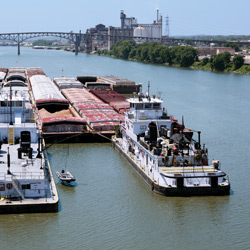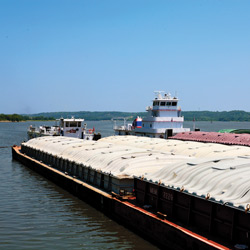
With about 30,000 vehicles passing daily over the Illinois Waterway via five bridges in the Peoria-Pekin area, one might think that the ongoing movement of river barges would be etched on our collective regional consciousness. Diesel-powered towboats pushing as many as 15 barges at a time are almost constantly in view on the Illinois, and their spectacle is especially impressive during the winter months, as the lash-ups plow through the ice floes lining the narrow channel. Yet most residents pay little heed to the local significance of maritime activity, perhaps assuming that the business is “just passing through” en route to some faraway place where somebody will unload whatever mysterious goods are sealed in those floating warehouses.
The anonymity of river transportation probably suits most of the industry players just fine. Like other transport modes, the barge and towing trade has been around seemingly forever and hasn’t recently seen dramatic technological breakthroughs. Today’s towboats are incrementally more powerful and the barge varieties more customized to the commodities they carry, but the concept is pretty much the same as it ever was. What has changed, much like rail and truck and air, is the regulatory environment, and the freedom barge carriers now enjoy to price their services based on volume and to transact almost all of their business under confidential contracts with their customers.
A few numbers help to put all this into perspective. In 2007, the U.S. Army Corps of Engineers recorded just under 31 million tons of cargo moving through its Peoria Lock & Dam, located outside Pekin and readily visible from eastbound I-474. What might surprise some locals is that about 13 million of those tons originated or terminated within the six counties that line the river in central Illinois.
At last count, 38 barge terminal facilities are currently active in the region, most of them specialized for particular types of business. Not surprisingly, 21 of these terminals are oriented toward handling grain and related agricultural products, and are operated by integrated grain marketers like ADM, Cargill and Growmark/FS, as well as several farmers’ cooperatives. These are basically large grain elevators with a barge dock attached, and the huge volumes of corn, beans and sorghum they load are primarily headed south to an amalgam of even bigger elevators in southern Louisiana, where the contents eventually end up on deepwater vessels headed for export markets around the world.
 The dominance of grain business gives the central Illinois cargo profile a decidedly southbound flair, and the big logistical challenge for the barge carriers is finding other types of cargo for the return haul back to the Illinois Waterway from the Gulf Coast. The range of northbound commodities is surprisingly diverse, including a mix of fertilizer, crude and refined petroleum products, coal, steel, and manufactured goods, offloaded at 17 docks in our area. The Heart of Illinois Regional Port District, branded as TransPORT, helps terminal operators promote these sites and publishes a regional river map indicating locations of all private facilities.
The dominance of grain business gives the central Illinois cargo profile a decidedly southbound flair, and the big logistical challenge for the barge carriers is finding other types of cargo for the return haul back to the Illinois Waterway from the Gulf Coast. The range of northbound commodities is surprisingly diverse, including a mix of fertilizer, crude and refined petroleum products, coal, steel, and manufactured goods, offloaded at 17 docks in our area. The Heart of Illinois Regional Port District, branded as TransPORT, helps terminal operators promote these sites and publishes a regional river map indicating locations of all private facilities.
Barge operators engage in two distinct activities on the waterway. Barge fleeting is the marshalling of idle barges while they await an available berth at one of the terminals, and takes place at designated river markers where the barges will not obstruct the navigation channel. The big fleeting player on our stretch of river is American Rivers Transportation Company (ARTCO), an operating unit of Archer Daniels Midland. In addition to fleeting, ARTCO also engages in the other basic chore, that of serving as a common carrier on the waterway system, which mandates a fleet of towboats and access to owned or leased barge fleets. Other carriers serving the Illinois include AEP River Operations (formerly Memco), American Commercial Lines, Canal Barge Line and Ingram Towing. They are to the river system what Roadway Freight is to trucking and Union Pacific is to railroads.
The efficiency of waterway transportation is above reproach: a single barge loaded with grain displaces 15 railcars or 58 trucks. The fact that one towboat can push 15 barges renders this mode very environmentally friendly, or “green” in the current vernacular. The rub, of course, is speed, or more specifically, the lack thereof. River operations limp along at an average of 11 miles per hour with the inevitable result that, if time is money, this isn’t your mode. Hence, the plain fact that the business base of the inland barge trade is overwhelmingly dry and liquid bulk commodities that tend to be low in value per ton versus consumer goods.
However, the total dominance of bulk commodities may well be short lived. The Panama Canal is currently being reconstructed to accommodate the largest ships in the world, a project that will wrap up in 2013. This will open up Gulf of Mexico ports such as New Orleans to the range of behemoth container vessels which heretofore have not ventured beyond Pacific Coast ports. Combine that with the prospect of a new “platform” container terminal being built on the extreme lower Mississippi River, and the possibility of handling ocean containers by barge to points as far upstream as Peoria may not be inconceivable.
Many in the barge industry still roll their eyes at the prospect of barges carrying as many as 90 ocean containers apiece steaming up the river, but the concept has solid backing from the U.S. Department of Transportation as a partial antidote to railway and highway congestion. The USDOT’s Maritime Administration has gone so far as to introduce a “Marine Highways” initiative, wherein designated river and coastal corridors will establish eligibility for federal funding to put new cargo infrastructure into place and assist start-up barge ventures. The idea is to put the waterways in position to furnish the marketplace with a new transportation option.
As the public port authority for central Illinois, TransPORT envisions a more diversified logistics base for our region. The initial trial balloon will be TransPORT’s forthcoming acquisition of the old Caterpillar foundry near Mapleton, with plans to revitalize the site into a major cargo transloading center for rail, truck and barge, accompanied by light manufacturing and distribution facilities.
As always, the marketplace will decide which new concepts pan out, and it will no doubt dictate midstream adjustment to the best-laid plans, but in any case, there’s no disputing the commercial contribution and economic impact of water transportation for the Peoria region. So the next time you’re cresting the Murray Baker or McCluggage, take a quick glance downward (without jeopardizing your fellow motorists, of course) and have a gander at one of our true economic engines. iBi
Steve Jaeger is executive director of the Heart of Illinois Regional Port District (branded as TransPORT), based in Peoria.

